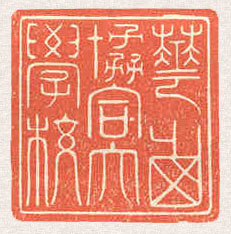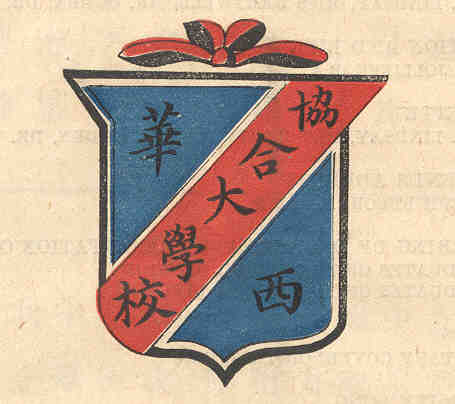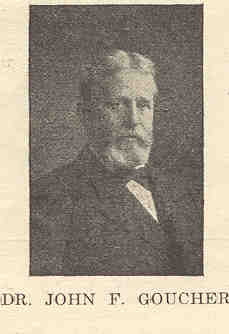West China Union University

The West China Union University (WCUU), located
in Chengtu (alternate spelling: Chengdu), Szechuan Province, China, was
the product of the collective efforts of four Protestant, denominational,
missionary boards  and
eventually became a division of the West China Educational Union (WCEU),
which was created in 1906. Once established, the University had a difficult
task in converting the people of Szechuan province--an area in size equal
to the United Kingdom, France, and Germany combined--as it was the only
institution with a Christianizing purpose in the region; the faculty and
administration were attempting to convert the beliefs of a population in
excess of 100 to 150 million people.1
and
eventually became a division of the West China Educational Union (WCEU),
which was created in 1906. Once established, the University had a difficult
task in converting the people of Szechuan province--an area in size equal
to the United Kingdom, France, and Germany combined--as it was the only
institution with a Christianizing purpose in the region; the faculty and
administration were attempting to convert the beliefs of a population in
excess of 100 to 150 million people.1
As of 1914 the WCEU consisted of 106 schools in Szechuan province serving 2597 boys in their studies as well as the main university. In addition to the higher education provided by the Educational Union, on the lower levels of education it had charge of curricula, exams, the conferring of certificates, and supervising of first and secondary educational work in all missions. In 1903 Dr. John W. Yost, Dickinson Class of 1903, became the first Dickinson alumnus to find employ at the WCUU; he was a Professor of Education. Prof. Yost kept up a correspondence with the administration at Dickinson and requested funding for an assistant to aid him in his duties. In response to Yost's request, the President of the College, J. H. Morgan, published an article in the Dickinsonian Supplement calling for student financial support and also paraphrasing the aims of the College in foreign fields: as he wrote, "the function of a College is to teach men to think in world terms instead of local terms."2 Furthering this message is the "Dickinson Creed,"3found in the same issue of the Supplement:
1.) We believe that all men are brothers, and the weakest has the first claim upon our sympathiesAs with many institutions of higher learning, much can be learned by studying how they received their funding. And, aside from the various Dickinson alumni that worked at the WCUU, funding was our primary means of support. A letter to the Dickinsonian from Dr. John F. Goucher, Class of 1868 and a founding member of the WCUU, addressed the question of "where [our] money goes"4when we send funds to the University; the money goes to help those Chinese whom want to learn. Those whom the school doesn't have room to teach are turned away, and are thus denied the chance to become Christians. This alone, according to Dr. Goucher, should be enough reason to financially support the WCUU. Financial matters were more directly tackled on Dickinson campus after the creation of the Dickinson College Extension Board (DCEB).
2.) We believe that the college is a place where students become familiar with a world of things.
Provincialism is inexcusable among college men.
3.) We believe that no student or alumnus of Dickinson is willing to see his college outdone by other
colleges.

The Dickinsonian; Vol. XLIX,
No 11, pg. 4
The Extension Board was created to further support the voluntary initiative on campus in relation to foreign affairs and affiliations. More so, as quoted in the Dickinsonian, the Constitution of the DECB stated that for "the interest of international goodwill and the advancement of education and Christian faith"5a professorship would be sponsored on the Chengtze campus. Support came from both current students and alumni in the annual "China Campaign." The money raised by this drive went to fund the professorship of a Dickinson alumnus on the WCUU faculty as well as to the erection of new buildings on the campus.
Following is a break down of the "China
Campaign"6for the Fall of 1921.
The numbers represented here are somewhat atypical of the funds collected
in other years; at this point in the history of Dickinson's involvement
with the West China Union University, enthusiasm was a bit higher than
the status quo:
| China Drive -- Fall 1921 | ||||
| Seniors | Juniors | Sophomores | Freshmen | |
| # of men in class | 40 | 49 | 32 | 49 |
| # of men contributing | 24 | 23 | 32 | 49 |
| Amount contributed (men) | $94.00 | $86.00 | $138.50 | $163.50 |
| # of women in class | 35 | 28 | 51 | 52 |
| # of women contributing | 20 | 16 | 31 | 39 |
| Amount contributed (women) | $95.00 | $55.00 | $110.50 | $164.50 |
| Amount contributed (classes) | $189.00 | $141.00 | $249.50 | $327.50 |
| Total contributed by students | ............. | ............. | ................... | $906.50 |
| Total contributed by faculty | ............. | ............. | ................... | $365.00 |
| Total contributed by alumni | ............. | ............. | ................... | $115.00 |
| Contribution per capita (men) | ............. | ............. | ................... | $4.00 |
| Contribution per capita (women) | ............. | ............. | ................... | $3.76 |
Rev. Raymond Brewer was recently established as the college's personal representative on the University faculty and the support of such prominent religious figures as Dr. Ralph A. Ward from the Board of Foreign Missions of the Methodist Episcopal Church helped to make the money donated this year higher than in other years, comparatively speaking. For example, when the fund was established in 1914 to support Prof. Yost's assistant, only $300 was raised, as compared to the 1920 figure of $1000.7

The Dickinsonian; Vol. XLIX,
No 11, pg. 2
Brewer, if not the most active
Dickinsonian in China, certainly is the most documented Dickinsonian.
By way of numerous letters and reports, we have a fairly clear picture
of his actions and duties while serving at the WCUU. However, by
the mid 1920s, relationships with the Chinese government and many of the
people there had become strained. Growing anti Christian and anti
Western sentiment was once again a concern. As documented in Brewer's
Fourth Annual Report, "the missionaries have been regarded by the
Anti-Christian Movement as the representatives of a cultural invasion having
as its aim the subjugation of the East to the West."8
The above Dickinson Alumnus articles illustrate two points previously made, that of Brewer's genuine interest in the Chinese people and that of Dickinson's financial support of the West China Union University. What the articles fail to mention is the growing problems in China that would eventually force the closing of the West China Union University in 1926.9 Though the University reopened after conditions returned to normal, the situation did not remain stable long, and on August 1, 1929 the West China Educational Union was closed itself.10
Throughout its existence, the West China Union University, and, by extension, the West China Educational Union, sought to bring Chinese nationals closer to a Western ideal of behavior and way-of-life. However egocentric that mission may have been, it was typical of the view held by Westerners. The pattern of Dickinson interest in the WCUU throughout its involvement with the school seems to follow a pattern similar to the level of tension between the Chinese people and the foreign presence there. As tension rose, Dickinson financial support fell, and, by the time the West China Educational Union closed in 1929, the economic support had fallen to levels not seen since the first years of Prof. Yost's tenure at the University.
[top]
2. "Why Go Into a Foreign Field to Distribute Your Good Work When There Is So Much to Be Done at Home?" The Dickinsonian Supplement. Nov. 19, 1914. Dickinson-in-China, 1921-27; Archives and Special Collections, Dickinson College, Carlisle, Pa.
3. "The Dickinson Creed." The Dickinsonian Supplement. Nov. 19, 1914. Dickinson-in-China, 1921-27; Archives and Special Collections, Dickinson College, Carlisle, Pa
4. Crawford, Walter M. "Where Your Money Goes." The Dickinsonian Supplement. Sept. 4, 1916. Dickinson-in-China, 1921-27; Archives and Special Collections, Dickinson College, Carlisle, Pa.
5. "China Campaign Opens Tomorrow with Meeting." The Dickinsonian, Dec. 2, 1921, pg. 1. Dickinson-in-China, 1921-27; Archives and Special Collections, Dickinson College, Carlisle, Pa.
6. "China Drive." The Dickinsonian, Dec. 17, 1921. Archives and Special Collections, Dickinson College, Carlisle, Pa.
7. "China Campaign Opens Tomorrow with Meeting." The Dickinsonian, Dec. 2, 1921, pg. 1. Dickinson-in-China, 1921-27; Archives and Special Collections, Dickinson College, Carlisle, Pa.
8. Brewer, Raymond R. Fourth Annual Report, Oct., 1925. Drop File: Brewer, Raymond R. Archives and Special Collections, Dickinson College, Carlisle, Pa.
9. The Dickinsonian, Nov. 11, 1926. Archives and Special Collections, Dickinson College, Carlisle, Pa.
10. Report of the West China Union University to the Board of Governors. Aug. 1, 1929. Dickinson-in-China, 1921-27; Archives and Special Collections, Dickinson College, Carlisle, Pa.
**The emblems at the beginning of the page are from actual West China Union University documents. The first emblem is the University Seal and the second is the emblem on the official graduation documents. These were both found in the Dickinson-in-China folder in the Archives and Special Collections of Dickinson College, Carlisle, Pa.